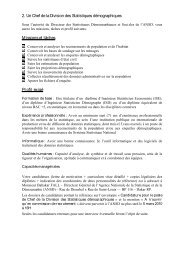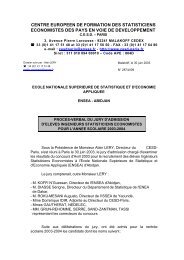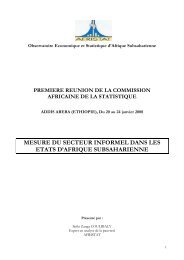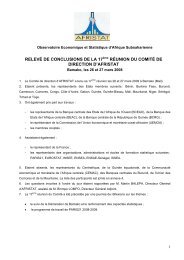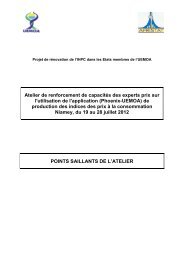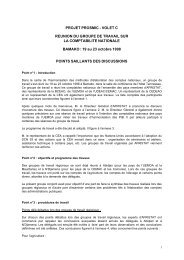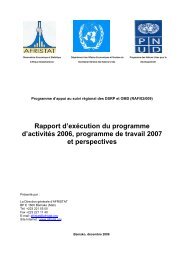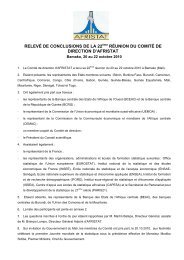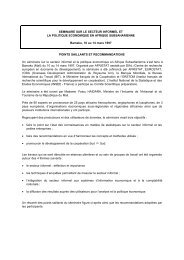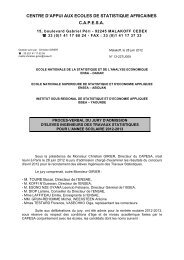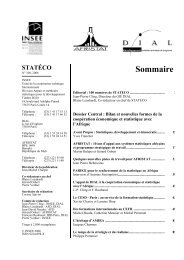Global Purchasing Power Parities and Real Expenditures - Afristat
Global Purchasing Power Parities and Real Expenditures - Afristat
Global Purchasing Power Parities and Real Expenditures - Afristat
Create successful ePaper yourself
Turn your PDF publications into a flip-book with our unique Google optimized e-Paper software.
Appendix F 185Eurostat-OECD results, with fixity maintained from thatpoint to the global report. Russia also participated in theCIS comparison. Therefore, the CIS was linked to theOECD using Russia as the link.The linking for the Eurostat-OECD <strong>and</strong> CIS regionswas done in the following stages: Eurostat computed basicheadingPPPs <strong>and</strong> expenditure weights for 37 economies:the 25 EU member states in 2005, the European Free TradeAssociation (EFTA) economies (Icel<strong>and</strong>, Norway, <strong>and</strong> Switzerl<strong>and</strong>),Albania, Bosnia-Herzegovina, Bulgaria, Croatia,Macedonia, Montenegro, Romania, Serbia, <strong>and</strong> Turkey. TheOECD combined these basic-heading PPPs <strong>and</strong> expenditureweights with those for nine other economies: its sevennon-European member economies plus Russia <strong>and</strong> Israel.It then calculated the 2005 Eurostat-OECD comparison instages to ensure that the final results at all levels of aggregationrespect fixity for three blocs of economies: the 37Eurostat economies, the 7 non-European OECD economies,plus Russia <strong>and</strong> Israel. This is basically the procedurethat was followed in the previous 2002 Eurostat-OECDcomparison.The CIS economies were linked to the Eurostat-OECDcomparison through Russia (that is, using Russia as a traditionalbridge country because it participated in both theCIS <strong>and</strong> the Eurostat-OECD comparisons). This in effectlinks the CIS economies to other regions through the fourring countries chosen to link Eurostat-OECD economieswith the rest of the world.Household ConsumptionEach region independently prepared lists of productsconsumed by households to be priced for the respectiveregional comparisons. A list of products was selected froma composite of these regional lists to be priced by a groupof 18 countries comprising two or more countries representingeach region. The prices from the ring list were usedto compute between-region PPPs, which were used to linkthe regions.The CPD method of aggregating price ratios to basicheadingPPPs was used in all regions except the Eurostat-OECD <strong>and</strong> CIS regions. The CPD method was also usedto compute the between-region PPPs at the basic-headinglevel for the ring comparison.The CPD method was chosen because it is more robustwhen the price matrix has missing data, <strong>and</strong> it providesestimates of st<strong>and</strong>ard errors. The residuals from the CPDregressions were used as a diagnostic tool in the Dikhanovtables.The Eurostat-OECD <strong>and</strong> CIS regions used the EKS*method to compute basic-heading PPPs. The primary differencebetween countries using the CPD versus the EKS*method is that each country in the Eurostat-OECD <strong>and</strong>CIS regions assigned a code to each product to indicatewhether the product was representative of its economy. Itis assumed that representative products have lower pricesthan other products that, even though comparable, are notrepresentative of the country’s expenditure patterns. Therepresentativity indicator was used as a form of stratificationthat, in effect, imposed implicit weights reflecting thenumber of representative products each country priced.Economies in the Asia-Pacific, Africa, Western Asia, <strong>and</strong>South America regions that either had not participated inan international comparison for an extended period or hadnever participated had difficulty applying the representativityconcept; therefore, it was not used in their intraregionalcomparisons. None of the regions nor the Eurostat-OECDapplied the representativity concept to housing, government,equipment, or construction. Nor was it used for thering comparison.HousingAsia-Pacific <strong>and</strong> Africa found it difficult to carry out comparisonsfor rental <strong>and</strong> owner-occupied housing usingrental surveys or direct comparisons of quality-adjustedquantities. (These are the methods recommended in theICP Operational Manual <strong>and</strong> used by Eurostat-OECD <strong>and</strong>CIS.) Most of the comparisons in Eurostat were based onrental surveys. Quantity comparisons were carried out inthe CIS <strong>and</strong> linked through a group of EU economies thatdid both. South America used the quantity approach, <strong>and</strong>Western Asia used a combination of rental survey data <strong>and</strong>the quantity approach.Because the quantity approach did not produce consistentresults across economies in their region, Asia-Pacific<strong>and</strong> Africa used the per capita volume of consumption(excluding rents) as an approximation of the volume of



